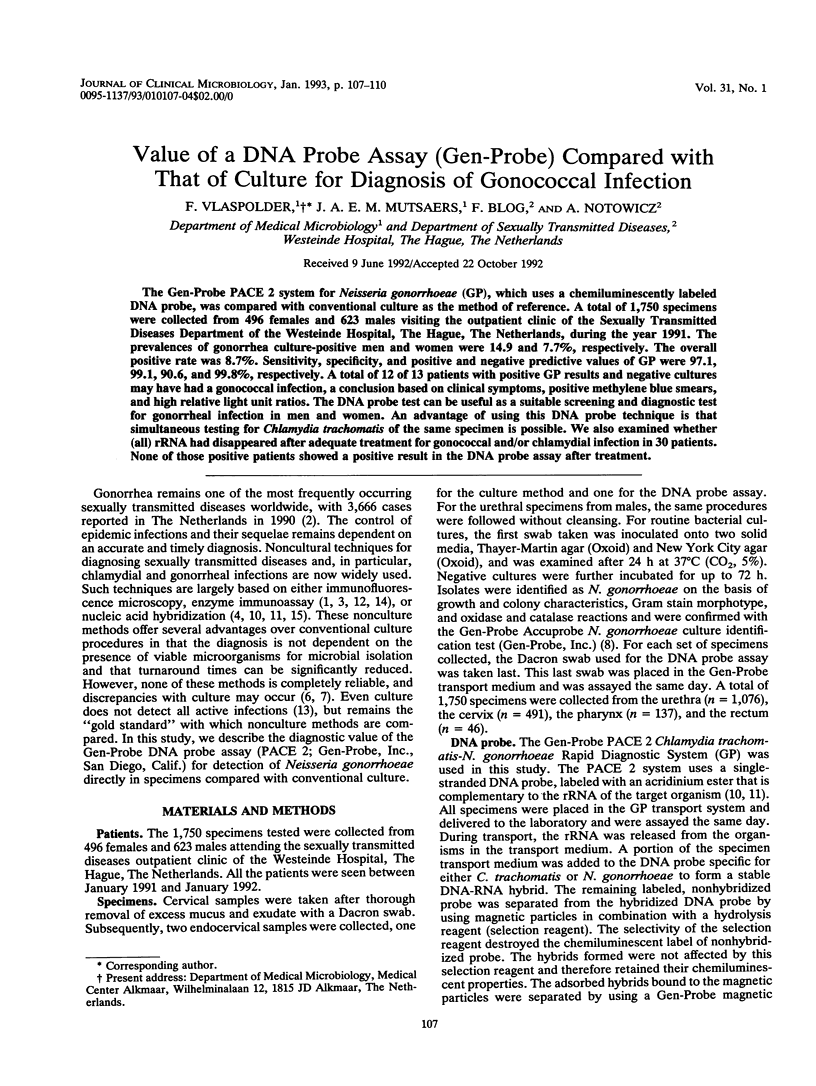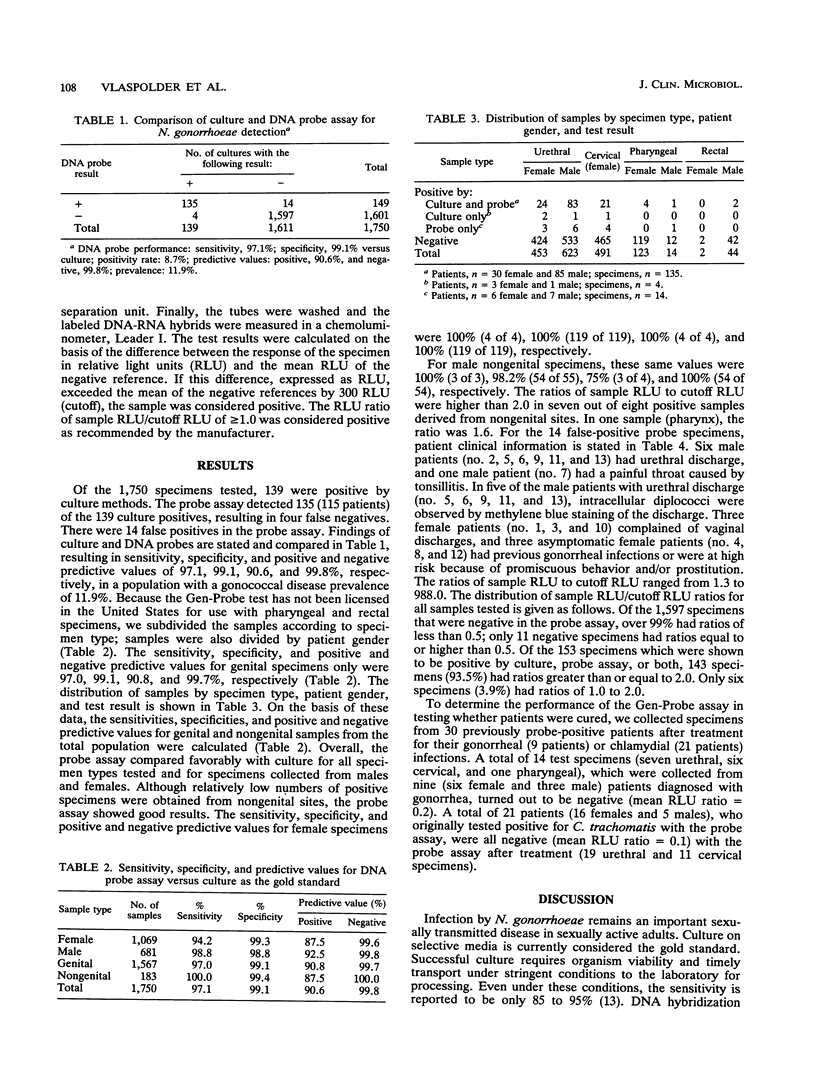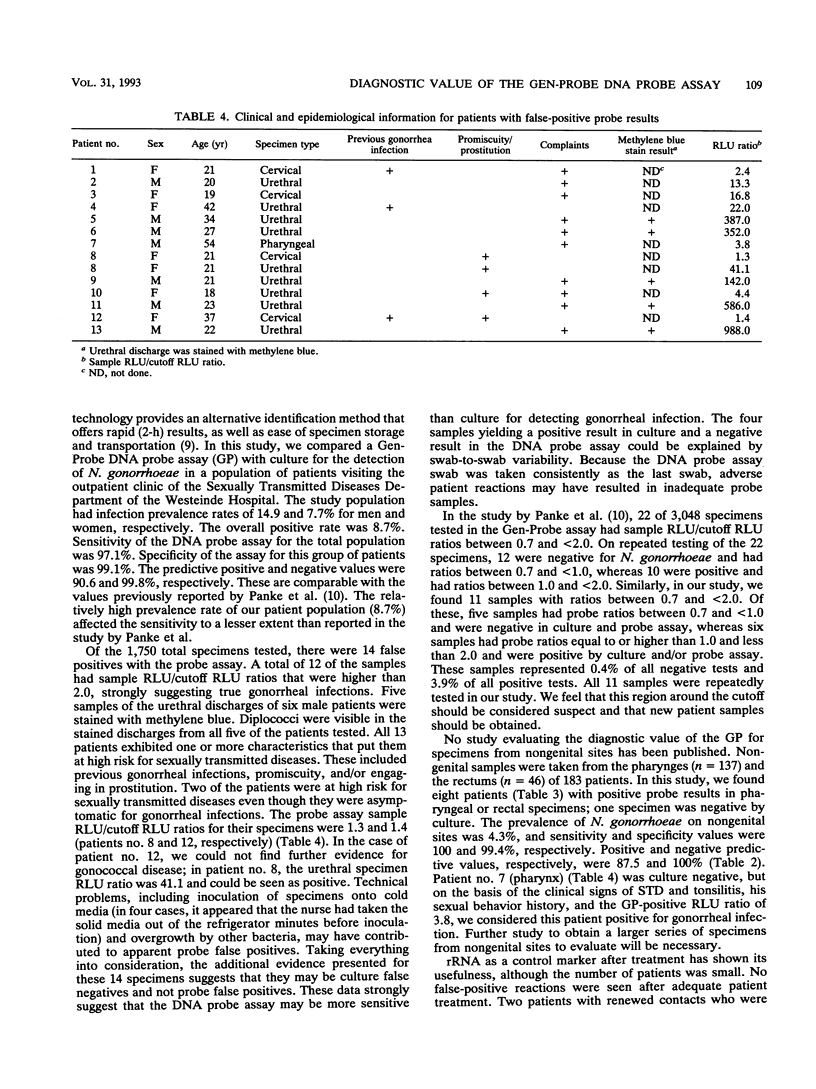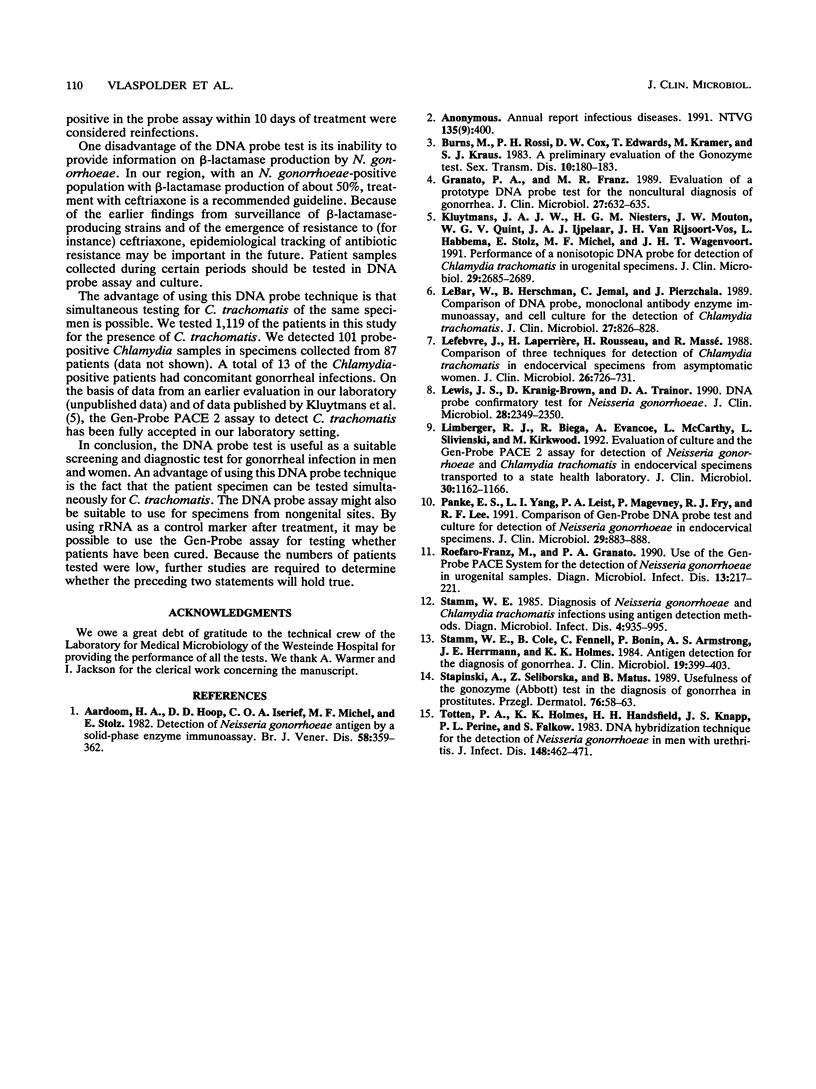Abstract
The Gen-Probe PACE 2 system for Neisseria gonorrhoeae (GP), which uses a chemiluminescently labeled DNA probe, was compared with conventional culture as the method of reference. A total of 1,750 specimens were collected from 496 females and 623 males visiting the outpatient clinic of the Sexually Transmitted Diseases Department of the Westeinde Hospital, The Hague, The Netherlands, during the year 1991. The prevalences of gonorrhea culture-positive men and women were 14.9 and 7.7%, respectively. The overall positive rate was 8.7%. Sensitivity, specificity, and positive and negative predictive values of GP were 97.1, 99.1, 90.6, and 99.8%, respectively. A total of 12 of 13 patients with positive GP results and negative cultures may have had a gonococcal infection, a conclusion based on clinical symptoms, positive methylene blue smears, and high relative light unit ratios. The DNA probe test can be useful as a suitable screening and diagnostic test for gonorrheal infection in men and women. An advantage of using this DNA probe technique is that simultaneous testing for Chlamydia trachomatis of the same specimen is possible. We also examined whether (all) rRNA had disappeared after adequate treatment for gonococcal and/or chlamydial infection in 30 patients. None of those positive patients showed a positive result in the DNA probe assay after treatment.
Full text
PDF



Selected References
These references are in PubMed. This may not be the complete list of references from this article.
- Aardoom H. A., de Hoop D., Iserief C. O., Michel M. F., Stolz E. Detection of Neisseria gonorrhoeae antigen by a solid-phase enzyme immunoassay. Br J Vener Dis. 1982 Dec;58(6):359–362. doi: 10.1136/sti.58.6.359. [DOI] [PMC free article] [PubMed] [Google Scholar]
- Burns M., Rossi P. H., Cox D. W., Edwards T., Kramer M., Kraus S. J. A preliminary evaluation of the Gonozyme test. Sex Transm Dis. 1983 Oct-Dec;10(4):180–183. doi: 10.1097/00007435-198311000-00003. [DOI] [PubMed] [Google Scholar]
- Granato P. A., Franz M. R. Evaluation of a prototype DNA probe test for the noncultural diagnosis of gonorrhea. J Clin Microbiol. 1989 Apr;27(4):632–635. doi: 10.1128/jcm.27.4.632-635.1989. [DOI] [PMC free article] [PubMed] [Google Scholar]
- Granato P. A., Franz M. R. Use of the Gen-Probe PACE system for the detection of Neisseria gonorrhoeae in urogenital samples. Diagn Microbiol Infect Dis. 1990 May-Jun;13(3):217–221. doi: 10.1016/0732-8893(90)90062-z. [DOI] [PubMed] [Google Scholar]
- Kluytmans J. A., Niesters H. G., Mouton J. W., Quint W. G., Ijpelaar J. A., Van Rijsoort-Vos J. H., Habbema L., Stolz E., Michel M. F., Wagenvoort J. H. Performance of a nonisotopic DNA probe for detection of Chlamydia trachomatis in urogenital specimens. J Clin Microbiol. 1991 Dec;29(12):2685–2689. doi: 10.1128/jcm.29.12.2685-2689.1991. [DOI] [PMC free article] [PubMed] [Google Scholar]
- LeBar W., Herschman B., Jemal C., Pierzchala J. Comparison of DNA probe, monoclonal antibody enzyme immunoassay, and cell culture for the detection of Chlamydia trachomatis. J Clin Microbiol. 1989 May;27(5):826–828. doi: 10.1128/jcm.27.5.826-828.1989. [DOI] [PMC free article] [PubMed] [Google Scholar]
- Lefebvre J., Laperrière H., Rousseau H., Massé R. Comparison of three techniques for detection of Chlamydia trachomatis in endocervical specimens from asymptomatic women. J Clin Microbiol. 1988 Apr;26(4):726–731. doi: 10.1128/jcm.26.4.726-731.1988. [DOI] [PMC free article] [PubMed] [Google Scholar]
- Lewis J. S., Kranig-Brown D., Trainor D. A. DNA probe confirmatory test for Neisseria gonorrhoeae. J Clin Microbiol. 1990 Oct;28(10):2349–2350. doi: 10.1128/jcm.28.10.2349-2350.1990. [DOI] [PMC free article] [PubMed] [Google Scholar]
- Limberger R. J., Biega R., Evancoe A., McCarthy L., Slivienski L., Kirkwood M. Evaluation of culture and the Gen-Probe PACE 2 assay for detection of Neisseria gonorrhoeae and Chlamydia trachomatis in endocervical specimens transported to a state health laboratory. J Clin Microbiol. 1992 May;30(5):1162–1166. doi: 10.1128/jcm.30.5.1162-1166.1992. [DOI] [PMC free article] [PubMed] [Google Scholar]
- Panke E. S., Yang L. I., Leist P. A., Magevney P., Fry R. J., Lee R. F. Comparison of Gen-Probe DNA probe test and culture for the detection of Neisseria gonorrhoeae in endocervical specimens. J Clin Microbiol. 1991 May;29(5):883–888. doi: 10.1128/jcm.29.5.883-888.1991. [DOI] [PMC free article] [PubMed] [Google Scholar]
- Stamm W. E., Cole B., Fennell C., Bonin P., Armstrong A. S., Herrmann J. E., Holmes K. K. Antigen detection for the diagnosis of gonorrhea. J Clin Microbiol. 1984 Mar;19(3):399–403. doi: 10.1128/jcm.19.3.399-403.1984. [DOI] [PMC free article] [PubMed] [Google Scholar]
- Stapiński A., Selibórska Z., Matus B. Przydatnoś testu gonozyme (Abbott) w rozpoznawaniu rzezaczki u prostytutek. Przegl Dermatol. 1989 Jan-Mar;76(1):58–63. [PubMed] [Google Scholar]
- Totten P. A., Holmes K. K., Handsfield H. H., Knapp J. S., Perine P. L., Falkow S. DNA hybridization technique for the detection of Neisseria gonorrhoeae in men with urethritis. J Infect Dis. 1983 Sep;148(3):462–471. doi: 10.1093/infdis/148.3.462. [DOI] [PubMed] [Google Scholar]


